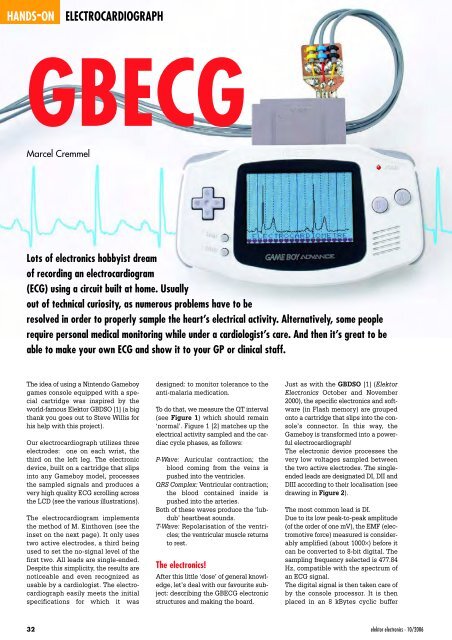FREE DVD
FREE DVD
FREE DVD
You also want an ePaper? Increase the reach of your titles
YUMPU automatically turns print PDFs into web optimized ePapers that Google loves.
HANDS-ON<br />
ELECTROCARDIOGRAPH<br />
GBECG<br />
Marcel Cremmel<br />
Lots of electronics hobbyist dream<br />
of recording an electrocardiogram<br />
(ECG) using a circuit built at home. Usually<br />
out of technical curiosity, as numerous problems have to be<br />
resolved in order to properly sample the heart’s electrical activity. Alternatively, some people<br />
require personal medical monitoring while under a cardiologist’s care. And then it’s great to be<br />
able to make your own ECG and show it to your GP or clinical staff.<br />
The idea of using a Nintendo Gameboy<br />
games console equipped with a special<br />
cartridge was inspired by the<br />
world-famous Elektor GBDSO [1] (a big<br />
thank you goes out to Steve Willis for<br />
his help with this project).<br />
Our electrocardiograph utilizes three<br />
electrodes: one on each wrist, the<br />
third on the left leg. The electronic<br />
device, built on a cartridge that slips<br />
into any Gameboy model, processes<br />
the sampled signals and produces a<br />
very high quality ECG scrolling across<br />
the LCD (see the various illustrations).<br />
The electrocardiogram implements<br />
the method of M. Einthoven (see the<br />
inset on the next page). It only uses<br />
two active electrodes, a third being<br />
used to set the no-signal level of the<br />
first two. All leads are single-ended.<br />
Despite this simplicity, the results are<br />
noticeable and even recognized as<br />
usable by a cardiologist. The electrocardiograph<br />
easily meets the initial<br />
specifications for which it was<br />
designed: to monitor tolerance to the<br />
anti-malaria medication.<br />
To do that, we measure the QT interval<br />
(see Figure 1) which should remain<br />
‘normal’. Figure 1 [2] matches up the<br />
electrical activity sampled and the cardiac<br />
cycle phases, as follows:<br />
P-Wave: Auricular contraction; the<br />
blood coming from the veins is<br />
pushed into the ventricles.<br />
QRS Complex: Ventricular contraction;<br />
the blood contained inside is<br />
pushed into the arteries.<br />
Both of these waves produce the ‘lubdub’<br />
heartbeat sounds.<br />
T-Wave: Repolarisation of the ventricles;<br />
the ventricular muscle returns<br />
to rest.<br />
The electronics!<br />
After this little ‘dose’ of general knowledge,<br />
let’s deal with our favourite subject:<br />
describing the GBECG electronic<br />
structures and making the board.<br />
Just as with the GBDSO [1] (Elektor<br />
Electronics October and November<br />
2000), the specific electronics and software<br />
(in Flash memory) are grouped<br />
onto a cartridge that slips into the console’s<br />
connector. In this way, the<br />
Gameboy is transformed into a powerful<br />
electrocardiograph!<br />
The electronic device processes the<br />
very low voltages sampled between<br />
the two active electrodes. The singleended<br />
leads are designated DI, DII and<br />
DIII according to their localisation (see<br />
drawing in Figure 2).<br />
The most common lead is DI.<br />
Due to its low peak-to-peak amplitude<br />
(of the order of one mV), the EMF (electromotive<br />
force) measured is considerably<br />
amplified (about 1000×) before it<br />
can be converted to 8-bit digital. The<br />
sampling frequency selected is 477.84<br />
Hz, compatible with the spectrum of<br />
an ECG signal.<br />
The digital signal is then taken care of<br />
by the console processor. It is then<br />
placed in an 8 kBytes cyclic buffer<br />
32<br />
elektor electronics - 10/2006

















